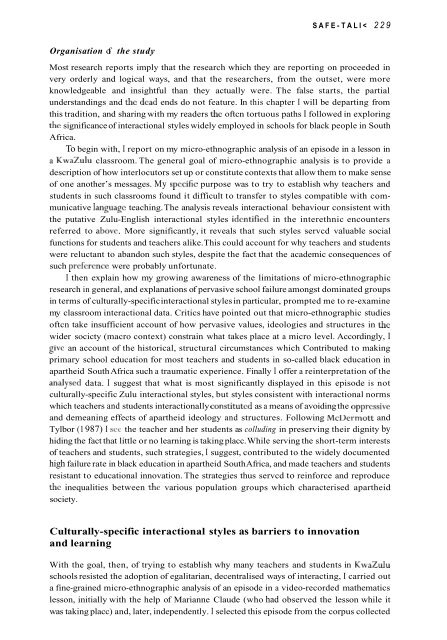English Language Teaching in its Social Context
English Language Teaching in its Social Context
English Language Teaching in its Social Context
Create successful ePaper yourself
Turn your PDF publications into a flip-book with our unique Google optimized e-Paper software.
SAFE-TALI< 229Organisation of the studyMost research reports imply that the research which they are report<strong>in</strong>g on proceeded <strong>in</strong>very orderly and logical ways, and that the researchers, from the outset, were moreknowledgeable and <strong>in</strong>sightful than they actually were. The false starts, the partialunderstand<strong>in</strong>gs and the dead ends do not feature. In this chapter I will be depart<strong>in</strong>g fromthis tradition, and shar<strong>in</strong>g with my readers the oftcn tortuous paths I followed <strong>in</strong> explor<strong>in</strong>gthc significance of <strong>in</strong>teractional styles widely employed <strong>in</strong> schools for black people <strong>in</strong> SouthAfrica.To beg<strong>in</strong> with, I report on my micro-ethnographic analysis of an episode <strong>in</strong> a lesson <strong>in</strong>a KwaZulu classroom. The general goal of micro-ethnographic analysis is to provide adescription of how <strong>in</strong>terlocutors set up or constitute contexts that allow them to make senseof one another’s messages. My spccific purpose was to try to establish why teachers andstudents <strong>in</strong> such classrooms found it difficult to transfer to styles compatible with communicativelanguagc teach<strong>in</strong>g. The analysis reveals <strong>in</strong>teractional behaviour consistent withthe putative Zulu-<strong>English</strong> <strong>in</strong>teractional styles idcntified <strong>in</strong> the <strong>in</strong>terethnic encountersreferred to abovc. More significantly, it reveals that such styles servcd valuable socialfunctions for students and teachers alike. This could account for why teachers and studentswere reluctant to abandon such styles, despite the fact that the academic consequences ofsuch preference were probably unfortunate.I then expla<strong>in</strong> how my grow<strong>in</strong>g awareness of the limitations of micro-ethnographicresearch <strong>in</strong> general, and explanations of pervasive school failure amongst dom<strong>in</strong>ated groups<strong>in</strong> terms of culturally-specific <strong>in</strong>teractional styles <strong>in</strong> particular, prompted me to re-exam<strong>in</strong>emy classroom <strong>in</strong>teractional data. Critics have po<strong>in</strong>ted out that micro-ethnographic studiesoftcn take <strong>in</strong>sufficient account of how pervasive values, ideologies and structures <strong>in</strong> thewider socicty (macro context) constra<strong>in</strong> what takes place at a micro level. Accord<strong>in</strong>gly, Igivc an account of the historical, structural circumstances which Contributed to mak<strong>in</strong>gprimary school education for most teachers and students <strong>in</strong> so-called black education <strong>in</strong>apartheid South Africa such a traumatic experience. F<strong>in</strong>ally I offer a re<strong>in</strong>terpretation of theanalysed data. I suggest that what is most significantly displayed <strong>in</strong> this episode is notculturally-specific Zulu <strong>in</strong>teractional styles, but styles consistent with <strong>in</strong>teractional normswhich teachers and students <strong>in</strong>teractionally constitutcd as a means of avoid<strong>in</strong>g the oppressiveand demean<strong>in</strong>g effects of apartheid ideology and structures. Follow<strong>in</strong>g McDermott andTylbor (1 987) I see the teacher and her students as collud<strong>in</strong>g <strong>in</strong> preserv<strong>in</strong>g their dignity byhid<strong>in</strong>g the fact that little or no learn<strong>in</strong>g is tak<strong>in</strong>g placc. While serv<strong>in</strong>g the short-term <strong>in</strong>terestsof teachers and students, such strategies, I suggest, contributed to the widely documentedhigh failure rate <strong>in</strong> black education <strong>in</strong> apartheid South Africa, and made teachers and studentsresistant to educational <strong>in</strong>novation. The strategies thus servcd to re<strong>in</strong>force and reproducethe <strong>in</strong>equalities between the various population groups which characterised apartheidsociety.Culturally-specific <strong>in</strong>teractional styles as barriers to <strong>in</strong>novationand learn<strong>in</strong>gWith the goal, then, of try<strong>in</strong>g to establish why many teachers and students <strong>in</strong> KwaZuluschools resisted the adoption of egalitarian, decentralised ways of <strong>in</strong>teract<strong>in</strong>g, I carried outa f<strong>in</strong>e-gra<strong>in</strong>ed micro-ethnographic analysis of an episode <strong>in</strong> a video-recorded mathematicslesson, <strong>in</strong>itially with the help of Marianne Claude (who had observed the lesson while itwas tak<strong>in</strong>g placc) and, later, <strong>in</strong>dependently. I selected this episode from the corpus collected












